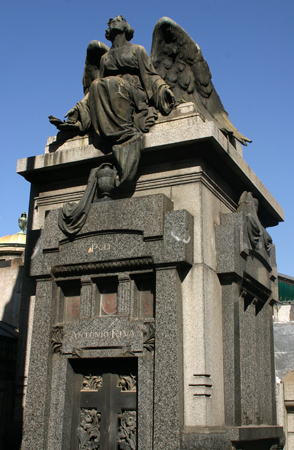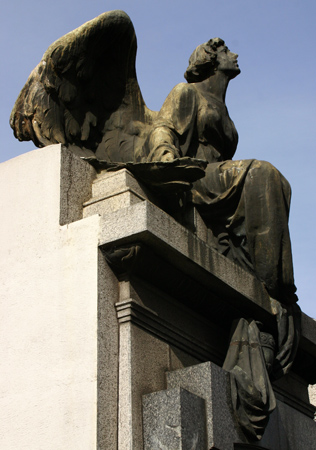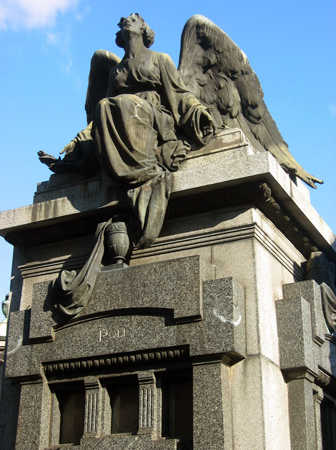
What a stunning statue of an angel gazing towards the heavens by Luigi Trinchero. Invited to Argentina by fellow Italian artist Victor de Pol in 1889, Trinchero directed a ceramics factory in La Plata that ultimately did not succeed. Soon after its closure, he returned to Italy.

However, Trinchero came back to Argentina at the insistence of Carlos Morra & this time would succeed. He established a workshop to produce ornamental sculpture… exactly what Buenos Aires needed as many aristocratic porteños rekindled their European origins & a building boom began. Trinchero decorated the Centro Naval, churches, schools & most famously the Teatro Colón.

A descendant of Antonio Riva has generously shared his family history with us. A portion of his comment is copied here. Thanks, Agustín!
Antonio Riva, whose name is featured on top of the mausoleum’s door is my great great grandfather. He was a wealthy Genovese born (who came to Argentina maybe in the 1860s) importer and salesman of food stocks in the late 19th and the early 20th century. He probably commissioned the sculpture from Trinchero at the same time the sculptor was famous for doing work in the Teatro Colon in Buenos Aires. The rest of the mausoleum was most likely built by other Italian workers who more or less made these in series, albeit really well. Antonio Riva’s daughter, Emma Riva, who was fond of art and Italian artists – sponsoring painters such as Angel Della Valle – was maybe involved in picking the sculptor for the mausoleum. Emma Riva married Giulio Poli, and that is why the surname Poli was added.
Wow, my dad just happened upon this page and sent it to me. Antonio Riva, whose name is featured on top of the mausoleum’s door is my great great grandfather. He was a wealthy Genovese born (who came to Argentina maybe in the 1860s) importer and salesman of food stocks in the late 19th and the early 20th century. He probably commissioned the sculpture from Trinchero at the same time the sculptor was famous for doing work in the Teatro Colon in Buenos Aires. The rest of the mausoleum was most likely built by other Italian workers who more or less made these in series, albeit really well. Antonio Riva’s daughter, Emma Riva, who was fond of art and Italian artists – sponsoring painters such as Angel Della Valle – was maybe involved in picking the sculptor for the mausoleum. Emma Riva married Giulio Poli, and that is why the surname Poli was added. In that Mausoleum are the remains of various generations of the families, from Antonio to my grandfather Carlos Alberto Poli and his siblings. A fascinating find, we had no idea that Trinchero was the artist of the sculpture we always found to be beautiful. Hopefully that little history was interesting.
Cheers,
Agustín.
That’s an amazing story, Agustín!! I love hearing about family history, & you definitely have helped add to everyone’s knowledge about this mausoleum. I’ll change a bit of the text to reflect what you’ve written. Thank you so much! I wish all families were as open & generous about sharing their history. Take care, Robert
It was my pleasure! Talking to my dad, recounting and then writing this short history was pretty cool, in spite of it being pretty fragmented and partially lost to time, like all history when the people who experienced it first hand are gone. That’s why I felt like writing down what little I could gather from a quick talk. Take care and keep up the good work!
Agustín.
Falta agregar que mi abuela Emma Antonia Carolina Riva de Poli obligo a los fundidores de bronce de la puerta que rompieran el tacelado del molde ,para evitar la copia.La puerta de dos hojas,bellísima,posee alegorías del sueño con ramilletes de flores de opio.
Hola Juan Carlos – Qué detalle tan interesante! Hay mucha copia dentro del cementerio pero obvio, no de esa puerta… es una belleza. Gracias por compartir la historia! Un saludo.